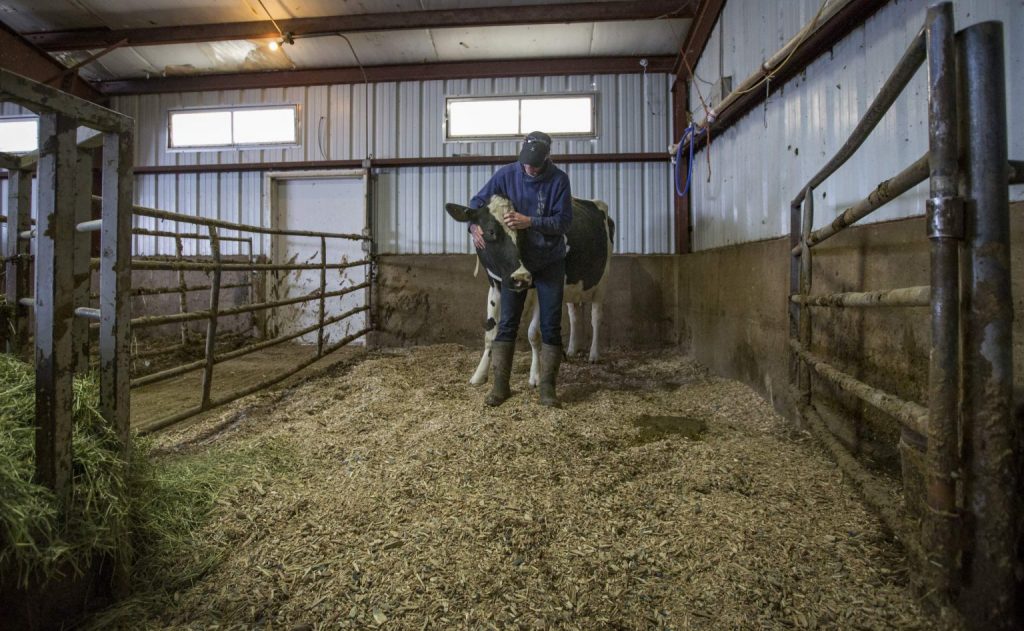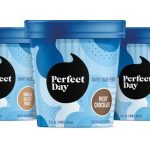
And the fourth-generation farmer thinks he sees a way to get there.
The Brown family owns about 300 acres of land between Coalville and Hoystville and has made a living off it for generations, but he says the farm is at a crossroads.
“The current business plan that has worked for us for 50-plus years no longer works going forward,” he said. “It’s not sustainable.”
Dairy farming has been central to the Browns’ livelihood since the mid-1950s, when they seized on an idea to revolutionize the industry by selling refrigerated tanks that changed how milk made its way from cow to grocery store.
“Once I’m gone, that’s it,” dairy farmer Mike Brown on the state of dairy farming in Summit County.
Soon after, they ramped up their dairy production, milking around 300 cows from their spot on Brown’s Lane and selling milk under the label Brown’s Summit Valley Dairy.
For many years, the Browns had a small store on their property that sold farm-fresh milk and other drinks; they were famous for having the best skim and chocolate milk and cream that could be whipped faster than anyone else’s, Brown said.
In the late 2000s, they sold the label to another farm, stopped processing on-site and closed the store. They continue to milk around 280 cows and ship the product to a cheesemaker.
With the dairy industry in decline and a 60-year-old farm, Brown is looking to innovate once again to create a different future for his four kids.
The farm is on the market and Brown says he’ll sell to the highest bidder. He says he has three options: Get out of farming entirely, move elsewhere and start another agricultural operation or find a way to stay and reinvest in a different kind of dairy farm.
That’s where the robots come in.
Brown said is looking to create a futuristic agritourism destination where schoolchildren and tourists can come out and see cows giving birth and being milked in a clean environment with the human element nearly removed.
That sort of innovation, while it may not fit with an image of the farming days of yore, is something the Browns and many farmers have had to do to meet the challenges of the day.
Brown’s father, Glenn, recalls earlier days in Summit County when “everyone milked a cow.” Now, those numbers have dwindled, and the Browns are one of the last large dairy farms left.
Mike Brown said his farm is at an economic disadvantage having to freight everything in and out, and that he’s competing against larger farms whose buying power gives them economies of scale that he can’t match.
He could break even for a while, he said, but the farm is at the mercy of outside forces like commodities markets and feed prices, and he is reluctant to make the necessary investments in his land just to keep the status quo going.
Brown estimates it will cost a few million dollars to make his agritourism vision a reality, and there are plenty of challenges in the way, both in developing a local market that will buy the specialty products and in generating enough capital to make it happen.
Some of his neighbors may also have a say in whether his idea comes to fruition.
It relies in part on the success of a novel land-planning committee that is working to design a new town near Hoytsville. The Cedar Crest Village Overlay Committee is made up of local landowners and is attempting to come up with the best way to use about 1,000 acres of land. Mike Brown is on the committee and his 300 acres are included in the project area.
Committee members are creating a plan that, if adopted, could guide development in the area. They are weighing things like where the town’s main street and commercial core should go, which areas should be parks and open spaces and where to put residential areas.
Brown envisions selling off much of his land and providing an agritourism element for the village.
He hopes the town will provide the market for his products in the people who will live there, the incentive to put in a new exit from Interstate 80 to enable easy access for tourists and the capital he needs by allowing him to sell his farm or subdivide and sell off parts of it.
Brown, as is common in farming, borrows against the equity in his farm to make large up-front purchases for things like animal feed, but is restricted in how much money he can make by selling his land, as current zoning designations limit how many housing units can be put on it. Those limits could change if the village overlay process continues to proceed.
“The only way I’d be willing to reinvest is if there’s development, growth, if there’s a demographic shift,” Brown said. “People who are here now could care less how I milk my cows. The new generation are enthralled by it.”
He says that farming as a profession is becoming a harder sell as the economic benefits shrink and some of his peers are forced to have another full-time career to make ends meet.
“The next generation isn’t willing to drive to Salt Lake for a day job to subsidize the farm,” he said. “I believe we’re a half-generation away from losing touch with agriculture.”
Standing in what used to be the farm’s store, Glenn Brown nods his head in the direction of the dairy operation.
“That barn has never missed a milking since 1961,” he said.
If his son has his way, that run might come to an end sooner than later, ushering in one more innovation for the Brown family and a different kind of dairy farming for Summit County.
Farm of the future?
One part of Mike Brown’s vision for the future of his dairy farm is already in place, though it may need some new paint.
The Summit Valley Milk sign still hangs at the Brown family farm on Brown’s Lane near Hoytsville. For many years, the small store was open a few hours each afternoon and sold farm-fresh milk and other items to customers from the East Side and elsewhere who wanted locally sourced products.
Brown envisions opening the shop once again, but this time adding items like specialty cheeses and ice cream for tourists or families who may have stopped by to see how milk is made or to get a tour of the dairy operation.
It’s part of a plan to radically change the 60-year-old dairy operation into a modern agritourism destination that is 100% automated and virtually removes the human element from farming.
Brown said it’s necessary to make it in today’s economic landscape.
“If I’m going to stay, it has to change,” he said of his farm’s business model. “It’s not sustainable.”
His operation currently milks about 280 cows twice a day with the cows living in open-air enclosures.
His vision calls for downsizing the number of cows, building a new barn to contain the entire operation and investing in robotic milking stations that cows can access on their own, choosing when and how often.
Having everything inside and out of the elements cuts down dramatically on the environmental impact of manure because it doesn’t get washed away by precipitation, Brown said, and there are automated devices that could clean the enclosure.
The self-contained operation makes it perfect for attracting tourists, Brown said. Everything from birthing to milking could be on display.
Brown said the farm recently went from three milkings per day to two, cutting down on production. He said he made the move because he couldn’t find labor. When cows milk themselves, they average about three-and-a-half times per day, he said.
The machines read the cow’s tag and then uses the information it has saved about each individual cow to locate the teats, clean them and start milking. The milk is tested for many qualities, Brown said, and the machine is able to separate the cows that are in heat or those that might be ill into a separate pen.
He said he’d be able to run the operation with one other employee, cutting down on labor costs.
Brown worries that as family farms disappear people are losing touch with agriculture and animals. He envisions a learning center where schoolchildren could come face to face with animals, a prospect he said is becoming more rare.
The challenging landscape of the dairy industry has hit Summit County’s farmers, and Brown said he’s the last major holdout.
“Once I’m gone, that’s it,” he said. “This has the potential to save ag (in Summit County).”
The Browns’ farming timeline
Early days
The Browns come to Utah in the 1870s. Over the next decades, they sell and fix farm equipment and machine parts under the name Brown Implement.
Mid-1950s
The Browns start manufacturing refrigerated dairy tanks, selling them across the West and ramping up their dairy production.
Early 1960s
The family constructs its present-day dairy operation, milking 300 cows and bottling on-site.
2000s
The family sells its Brown’s Summit Valley label to another operation and stops processing on-site. The farm remains as one of the last large-scale dairy operations in Summit County, milking around 280 cows.
Present day
Mike Brown is at a crossroads. Faced with an aging farm and an unsustainable business model, he’s looking to agritourism and a pared-down, roboticized milking operation as a way of the future.

























